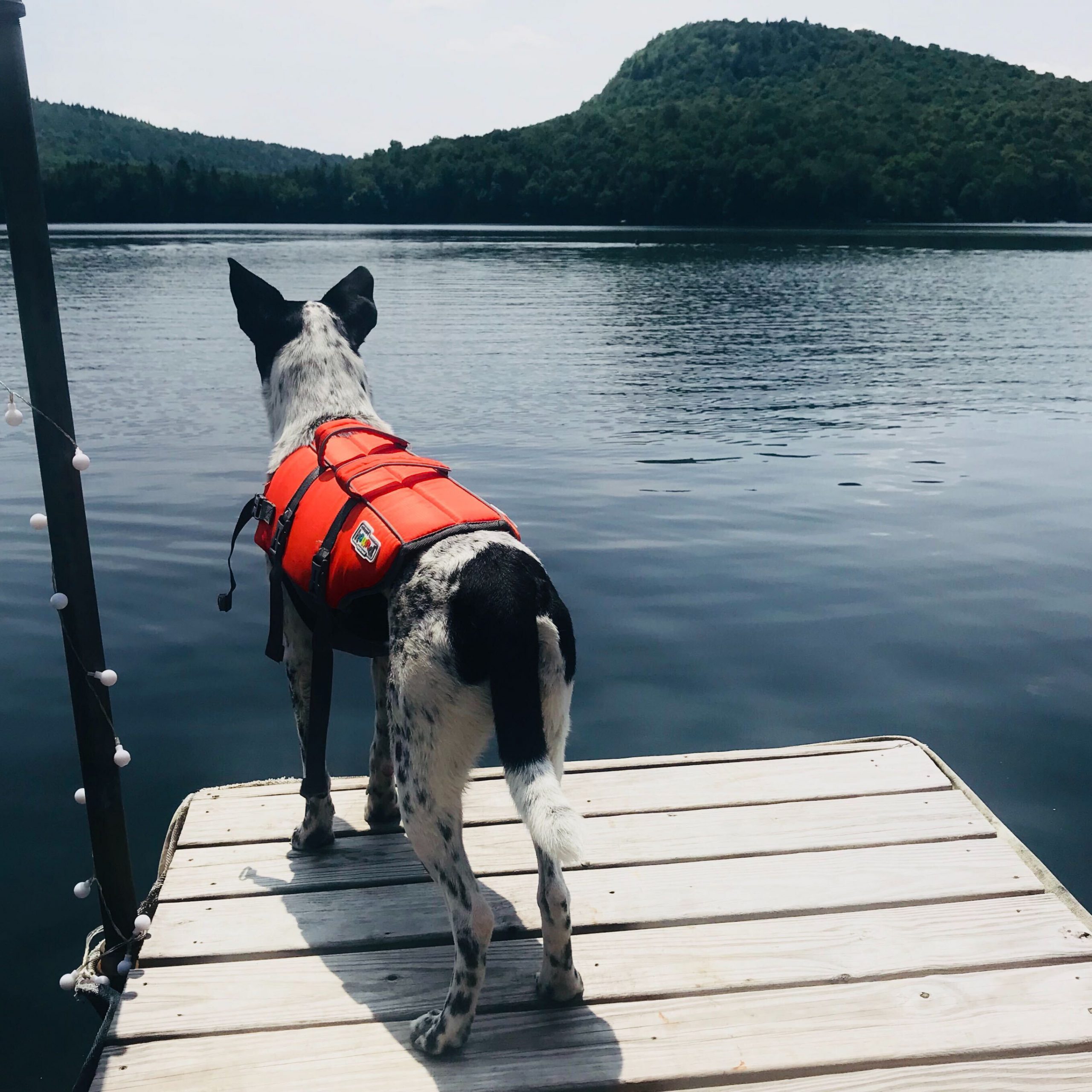Between swimming’s physical and mental benefits, there are many good reasons to introduce a dog to the water. Many humans will tell you that leaping into the pool on a hot day is among their pup’s favorite pastimes—and, for dogs who enjoy it, swimming can be a fun way to cool down and get a low-impact workout.
But, because it can also bring certain risks, you should be careful about which dogs you put in the water and how you go about teaching them to swim.
The benefits of swimming for dogs
If your dog is up for it, swimming can provide heart-pumping aerobic exercise while also strengthening muscles. “Swimming is one of the most comprehensive aerobic exercises that both dogs and humans can be engaged in,” says Jonathan S. Block, DVM, founder of West Delray Veterinary in Florida. “And what makes [it] even more beneficial, especially for dogs who might be experiencing some orthopedic or neurological issues, is that it is completely low-impact on the bones and joints.” Provided you get the OK from your vet, it’s a great activity for older or overweight dogs.
Do all dogs know how to swim?
Not all dogs will enjoy or excel at swimming. Depending on their bodies and dispositions, certain pups may have an easier or harder time learning than others.
“I’ve seen dogs unknowingly run into a body of water and sink straight to the bottom,” says Dr. Block.
Members of some breeds—like Labrador retrievers, poodles, and Portuguese water dogs—usually take to the water with great enthusiasm and ability. Other dogs may have more trouble. French and English bulldogs, for example, are brachycephalic—they have flat snouts that make breathing difficult.
But Dr. Block says that dogs of any breed can swim with proper precautions. “I wouldn’t say that swimming is contraindicated for brachycephalic dogs,” he explains. “It’s more about not allowing them to get stressed. So if they are very calm in the environment, then they can swim safely and effectively—especially if closely monitored.” This means staying with your dog and ending your session if they show any signs of stress or breathing trouble. With flat-faced dogs, these measures are wise for any form of exercise. Dr. Block also warns that brachycephalic dogs have an increased risk of aspiration—breathing in water—when swimming, which is another reason to stay by their side and protect them.
No matter what, you should supervise any dog who’s swimming, start them out in a life jacket, reward them with lots of treats, and be ready to rescue them if they show signs of distress or fatigue.
How to teach a dog to swim
If you want to teach your dog how to swim, put them in a life jacket first. Find one that fits them well and makes them float—dogs have different sizes and shapes, and the jacket won’t be much use if it slips off or they sink while wearing it.
Start the dog off in shallow water, and stay near them. While they are safely close to you and wearing the floatation device, watch and see what they do. A dog who’s taking to the water should start to figure out how to move around by paddling.
Swimming in a life jacket, with their human handling them at first, helps dogs have a good first experience with the activity. “They can build trust with the floatation devices,” says Dr. Block, “so that when they’re in the water they are calm and relaxed, and understand that they don’t have to swim for survival— they can swim for exercise. When you’re swimming a dog for a therapeutic benefit or controlled exercise, you want them to be relaxed. You don’t want them to get in there and have to do the doggy paddle and have to swim for survival.”
This is a new experience for your dog, so give them lots of treats and praise to help them get comfortable. If they have any dog friends who already like swimming, it may help for them to watch their peers having fun in the water.
Never force your dog to go further into the water if they’re scared—if you push your dog too far, you could make their fear worse and reduce the chances that they’ll ever have fun swimming. Only continue each session for as long as they’re enjoying it. If they get overwhelmed, take a break.
Be careful, and know the differences between bodies of water
Even if your dog seems like a strong swimmer, you need to take precautions. It’s a good idea to use a life jacket, especially in any large body of water—anything bigger than your own pool where you can leap in and rescue the dog at a moment’s notice.
Certain natural bodies of water could be home to animals—like snakes or even sharks, for example—that could attack a dog.
If your dog is swimming at the beach, be aware that sometimes currents are stronger than they appear and could start to become too powerful for the dog to paddle against. Stay nearby and be ready to help them if they need it.
Another possible danger for swimming dogs is the temperature of the water. If it’s too chilly for you to swim, it’s likely that it’s also too cold for your dog; use common sense and watch to see if your dog seems comfortable.
Always supervise a dog who’s swimming
You have to keep an eye on your dog when they’re swimming, even if they’re very good at it. Dogs may get overexcited when swimming and go too far out to swim back on their own power—if you don’t supervise them and spring into action if necessary, they could drown.
Don’t let your dog drink water while they’re swimming
Some bodies of water can contain substances that may harm a dog. Among them is blue-green algae, which is actually a name for a type of bacteria that often looks like algae when it grows in water.
Blue-green algae most often grows in stagnant or slow-moving water, and dogs who ingest it can face serious health consequences including death. Dogs may swallow it directly while swimming, lick it off of their fur, or get some in their mouths while playing with a ball or toy that has been in contaminated water. If you believe that your dog has swallowed blue-green algae, call a veterinarian right away so that they can receive treatment. If you think some got on their fur, give them a bath and call a vet. And if you have reason to believe that a body of water contains blue-green algae, keep your dog far away from it.
A small amount of chlorinated water from a swimming pool shouldn’t harm your dog, but don’t let them drink it freely. If they drink more than a little bit, check with your vet. Your dog could get an upset stomach or, if they drink a lot, suffer worse consequences—but a veterinarian will be able to tell you what to watch for and whether to be concerned.
While your dog may only end up with an upset stomach or diarrhea from one gulp of salt water from the ocean, you should try your best to stop them from drinking it. If they drink a lot of it, they could die—so if your dog does drink any significant amount of salt water, call a veterinarian immediately and seek their advice on treatment.

Rinse your dog after they swim in a pool
Rinse your dog off with tap water and thoroughly dry them after each time they swim in a pool. If they only swim once in a while, you may also want to choose this time for a full bath with dog-safe shampoo. In the majority of cases, washing with shampoo more than around once per month is no good for your dog’s skin.
The chlorine in pool water can make dogs itchy or even change the color of their coats, and rinsing may help avoid or minimize those effects. No matter where your dog swims, if they have long hair, they may require some extra-vigilant brushing afterwards.
If your dog is routinely getting wet, you should clean their ears once or twice a week. Especially if they have floppy ears, the moisture could make them more vulnerable to an infection.
Bathe your dog after they swim in a natural body of water
Dr. Block says that its best to treat dogs who’ve gone swimming in natural bodies of water, like oceans or lakes, as having gotten dirty. As such, they should get a full bath. And, again, it’s crucial to dry them thoroughly—dogs who are left wet for too long are at risk for issues like skin infections.

Don’t forget the sunscreen
Hairless dogs, those whose coats are thin or light in color, and those with light-colored noses can benefit from dog-safe sunscreen. If you let them stay out in the sun too long, they are vulnerable to burns. Ask your vet about safe, effective sunscreens for dogs.
Do what’s right for your dog
While this general advice is a good diving-off point for someone thinking about teaching a dog to swim, you should weigh their individual circumstances and pay attention to the signals they give you. “Every dog and every situation is unique,” says Dr. Block, “and every pet owner or veterinary professional should take into account the individual needs of the situation and use their best judgment to implement safety measures accordingly.”










